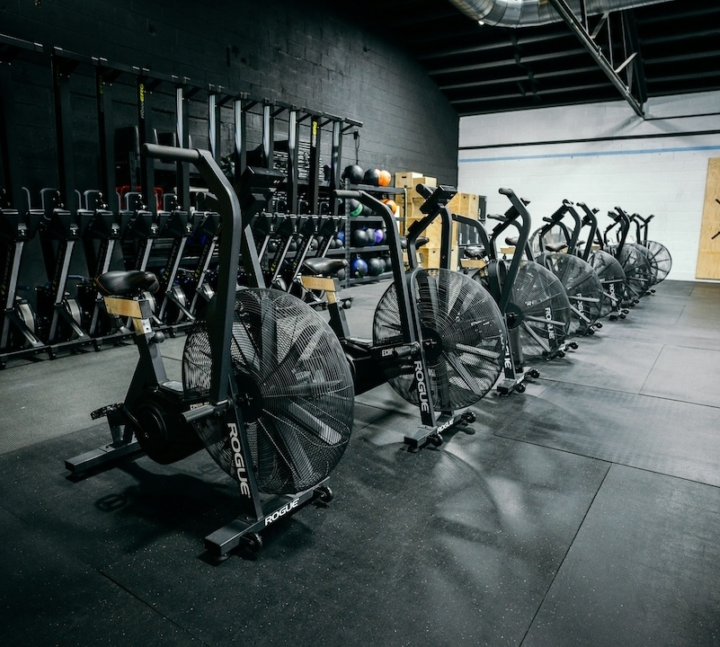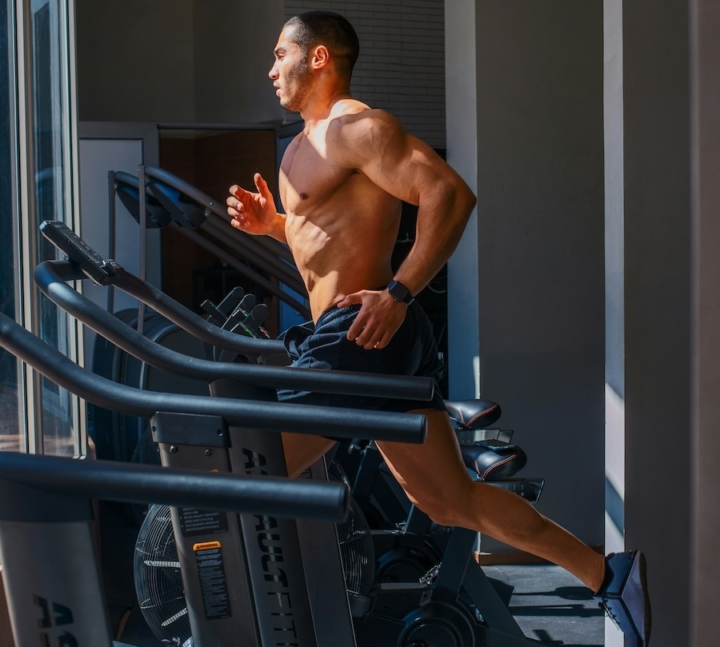Exercise
Rowing (Rowing Machine)
How to Perform - Rowing (Rowing Machine)
- Sit on the rower seat with your feet secured in the foot plates, knees bent, and hands gripping the handle with an overhand grip slightly wider than shoulder-width apart.
- Position your body in the catch position with your shins vertical, back straight but slightly forward from the hips, and arms extended.
- Begin the drive phase by pushing through your legs while maintaining a strong, stable core and keeping your arms straight.
- As your legs approach full extension, hinge at the hips to lean back slightly (about 100-110 degrees from your starting position) while maintaining a straight back.
- Pull the handle toward your lower ribs by bending your elbows and bringing them behind your torso, exhaling during this portion of the movement.
- Begin the recovery phase by extending your arms away from your torso first, maintaining your slight backward lean.
- Once your arms are fully extended, hinge forward at the hips to bring your torso back to the upright position, inhaling as you transition.
- Bend your knees to slide the seat forward, returning to the starting position while maintaining tension on the chain throughout the movement.
Important information
- Keep your back straight throughout the entire movement—never round your shoulders or lower back, even at the end positions.
- Maintain a fluid, continuous motion with a ratio of approximately 1:2 for drive to recovery (power phase should be quicker than the return).
- Avoid rushing the recovery phase, as proper sequencing (arms, torso, legs) allows for better technique and prevents energy waste.
- Adjust the damper setting according to your fitness level and goals—lower settings (3-5) typically work best for cardiovascular training while higher settings offer more resistance training benefits.
Primary Muscles
Muscle Groups
Mechanic
Risk Areas
Built for progress
Take the guesswork out of training
Create personalized AI-powered workout plans that evolve with you. Train smarter, track every rep and keep moving forward, one workout at a time.






Rowing on a machine offers a dynamic full-body workout that engages multiple muscle groups simultaneously, making it an intermediate-level exercise that delivers impressive results. When you're powering through each stroke, your lats are engaged as you pull the handle toward your body, creating that coveted V-shaped back over time. Your powerful quad muscles activate during the drive phase, while hamstrings and glutes work in harmony during the recovery, creating a lower-body trifecta of strength development. What many don't realize is how rowing silently transforms your core - your abs remain engaged throughout the entire movement as they stabilize your body between the drive and recovery phases.
The versatility of rowing makes it a standout choice for various training modalities. In HIIT workouts, alternating between high-intensity rowing sprints and recovery periods creates a metabolic furnace that continues burning calories long after you've stepped off the machine. CrossFit enthusiasts incorporate rowing for its measurable output and efficiency at building power endurance. Perhaps most underrated is rowing's role in recovery sessions, where maintaining a steady, moderate pace increases blood flow to muscles without the impact stress of other cardio options.
Rowing stands tall as an endurance builder, allowing you to develop impressive stamina as you log meters or time on the machine. The beauty lies in how it improves cardiovascular health while simultaneously developing muscular endurance. Your heart and lungs adapt to the rhythmic demands, improving oxygen delivery throughout your body. Unlike some cardio options that neglect upper body development, rowing's full-body engagement means you're building endurance across multiple muscle groups simultaneously.
Whether you're looking to supplement your existing fitness routine or make rowing your primary cardio choice, this efficient exercise delivers comprehensive benefits that few other machines can match - all while being gentle on your joints and adaptable to virtually any fitness level or goal.
FAQ - Rowing (Rowing Machine)
Rowing is a comprehensive full-body workout that primarily engages your lats, quads, hamstrings, glutes, and core. Your upper back, shoulders, and arms also activate during the pulling phase, making it one of the few exercises that effectively targets 85% of your body's muscles in a single movement.
Most rowing machines have adjustable resistance settings – beginners should start with lower resistance and focus on proper form and stroke rate (18-24 strokes per minute). As you advance, increase resistance gradually and experiment with interval training by alternating between high-intensity sprints and recovery periods.
The biggest mistakes include rushing the recovery phase, hunching your back, and improper sequencing of the rowing stroke. Remember the proper sequence: legs-core-arms on the drive, then arms-core-legs on the recovery, maintaining a straight back throughout the entire movement.
Yes, rowing is excellent for weight loss as it burns 400-800 calories per hour depending on intensity, while building muscle that increases your resting metabolic rate. The combination of cardiovascular conditioning and resistance training makes rowing more efficient for calorie burning than many other single-modality exercises.
For balanced fitness results, incorporate rowing 2-4 times weekly, varying between longer steady-state sessions (20-45 minutes) and shorter high-intensity intervals (10-20 minutes). Allow 48 hours between intense rowing workouts to let your muscles recover properly, especially when you're new to the exercise.










